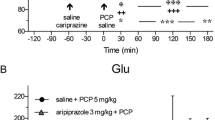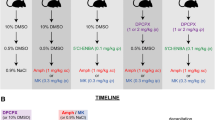Abstract
Phencyclidine (PCP) and sigma ligands produce a typical excitatory behaviour in rats, characterized by circling and head- and body-weaving. Excitatory amino acid antagonists such as 2-amino 5-phosphonovaleric acid (AP5) or 3-(±)-2-carboxypiperazin-4-yl)propyl-1-phosphonic acid (CPP) also produce a PCP-like excitatory behaviour in rats. In the present paper, the interactions between PCP/sigma drugs or excitatory amino acid receptor antagonists and haloperidol have been investigated in rats. In addition, the influence of two other butyrophenones having a different affinity for the sigma/haloperidol receptors, such as spiperone and 3-(4-(3(4-fluorobenzoyl)-propyl-piperazino-1-ylisoquinolino (HR 375), has been tested on the behavioural and EEG effects of PCP/sigma drugs and excitatory amino acid antagonists. PCP (2.5–5 mg/kg IP), (+) or (−) SKF 10,047 (1–15 mg/kg IP), (+) or (−) cyclazocine (2–8 mg/kg IP) and AP5 (0.5 µmol ICV) dose-dependently and significantly (P<0.01) antagonized the haloperidol-induced catalepsy in the horizontal bar and podium tests in rats. On the other hand, either haloperidol (1 mg/kg IP) or spiperone (1 mg/kg IP) reduced the head-weaving induced by (+) SKF 10,047, PCP, or AP5. On the contrary, HR 375 (6 mg/kg IP) was ineffective in blocking the excitatory effects of these drugs. In addition, either haloperidol (1 mg/kg IP) or spiperone (1 mg/kg IP), but not HR 375 (6 mg/kg IP) reduced the amplitude increase of the fast (20–30 Hz) frequency/low (30–50 µV) voltage background cortical activity elicited by PCP or (+) SKF 10,047. The results demonstrate an interaction between dopamine and excitatory amino acid receptors. At the same time, the data reveal the scarce relevance of the high affinity sigma/haloperidol receptors in the interference between PCP/sigma drugs and butyrophenones.
Similar content being viewed by others
References
Anis NA, Berry SC, Burton NR, Lodge D (1983) The dissociative anaesthetics, ketamine and phencyclidine, selectively reduce excitation of central mammalian neurones by N-methyl-aspartate. Br J Pharmacol 79:565–575
Bakker CB, Amini FB (1961) Observation on the psychotomimetic effects of sernyl. Comp Psychiatry 2:269–273
Berry SC, Dawkins SL, Lodge D (1984) Comparison of sigma and kappa-opiate as excitatory amino acid antagonists. Br J Pharmacol 83:179–185
Brady KT, Balster RL, May EL (1982) Stereoisomers of N-allylnormetazocine: phencyclidine-like behavioural effects in squirrel monkeys and rats. Science 215:178–180
Chen G, Ensor CR, Russel D, Bohner B (1959) The pharmacology of 1-(1-phenyl-cyclohexylpyperidine HCl. J Pharmacol Exp Ther 127:241–250
Dimpfel W, Spùler M (1990) Dizocilpine (MK 801), ketamine and phencyclidine: low doses affect brain field potentials in the freely moving rat in the same way as activation of dopaminergic transmission. Psychopharmacology 101:317–323
Domino EF (1964) Neurobiology of phencyclidine (Sernyl), a drug with an unusual spectrum of pharmacological activity. Int Rev Neurobiol 6:303–347
Fauman BJ, Aldinger G, Fauman M, Rosen P (1976) Psychiatric sequelae of phencyclidine abuse. Clin Toxicol 9:529–538
France CP, Woods JH, Ornestein P (1989) The competitive antagonist N-methyl-D-aspartate (NMDA) antagonist CGS 19 755 attenuates the rate-decreasing effects of NMDA in rhesus monkeys without producing ketamine-like discriminative stimulus effects. Eur J Pharmacol 159:133–139
Giannini J, Eighan MS, Loiselle RH, Giannini MC (1984) Comparison of haloperidol and chlorpromazine in the treatment of phencyclidine psychosis. J Clin Pharmacol 24:202–204
Girault JA, Malpain S, Greengard P (1990) Excitatory amino acid antagonists and Parkinson's disease. TINS 13:325–326
Hock FJ, Kruse H, Gerhards HJ, Konz E (1985) Pharmacological effects of HR 375: a new potential antipsychotic agent. Drug Dev Res 6:301–311
Holtzman SG (1982) Phencyclidine-like discriminative stimulus properties of opioids in the squirrel monkey. Psychopharmacology 77:295–300
Imperato A, Alivernini L, Scrocco MG, Bacchi S, Angelucci L (1990) Excitatory amino acids on dopaminergic and cholinergic transmission: potential therapeutic application. Neurochem Int 16[suppl 1]:44
Itzhak Y, Stein I (1990) Sigma binding sites in the brain; an emerging concept for multiple sites and their relevance for psychiatric disorders. Life Sci 47:1073–1081
Keats AS, Telford J (1964) Narcotic antagonists as analgesics In: RF Gould (ed) Molecular modification in drug/design. Advances in Chemistry series 45. American Chemical Society, Washington, pp 170–176
Koek W, Woods JH, Ornstein P (1986) Phencyclidine-like behavioural effects in pigeons induced by systemic administration of the excitatory amino acid antagonist, 2-amino-5-phosphonovalerate. Life Sci 39:973–978
Largent BL, Gundlack AL, Snyder SH (1984) Psychotomimetic opiate receptors labeled and visualized with (+) [3H]3(3-hydroxyphenyl)-N-(1-propyl)piperidine. Proc Natl Acad Sci USA 81:4983–4987
Lerner SE, Burns RS (2978) Phencyclidine use among youth: history, epidemiology, and acute and chronic intoxication. In: Peterson RC, Stillman RC (eds) Phencyclidine (PCP) abuse: an appraisal. NIDA Res Monogr, 21. National Clearing House of Drug Abuse Information, Rockville, Md, p 66
Luby ED, Gottlieb JS, Cohen BD, Rosenbaum G, Domino EF (1962) Model psychoses and schizophrenia. Am J Psychiatry 119:61–67
Lundberg GD, Gupta RC, Montgomery SH (1976) Phencyclidine: pattern seen in street drug analysis. Clin Toxicol 9:503–511
Metha AK, Tieku MK (1990) Role of N-methyl-D-aspartate (NMDA) receptors in experimental catalepsy in rats. Life Sci 46:37–42
Monnet FP, Debonnel G, Junien JL, De Montigny C (1990) N-methyl-D-aspartate-induced nuronal activation is selectively modulated by sigma receptors. Eur J Pharmacol 179:441–445
Sagratella S, Niglio T, Ortolani E, Scotti de Carolis A, Pezzola A (1985) Phencyclidine-like effect of cyclazocine on pentylentetrazol-induced seizures in laboratory animals. Pharmacol Biochem Behav 22:515–519
Sagratella S, Benedetti M, Pezzola A, Scotti de Carolis A (1989) Behavioural and electroencephalographic effects of excitatory amino acid antagonists and sigma opiate/phencyclidine-like compounds in rats. Neuropharmacology 28:57–61
Schmidt WJ, Bishoff C (1988) Dopaminergic behavioural responses modulated by NMDA receptor antagonists. Psycopharmacology 90:123–130
Schmidt WJ, Bubser M (1989) Anticataleptic effects of the N-methyl-D-aspartate antagonist MK-801 in rats. Pharmacol Biochem Behav 32:621–623
Scotti de Carolis A, Popoli P, Pezzola A, Sagratella S (1991) Differential influence of morphinan drugs on haloperidol-induced catalepsy in rats: a comparative study with an N-methyl-D-aspartate antagonist. Arch Int Pharmacodyn (in press)
Shannon HE (1982) Pharmacological analysis of the phencyclidine-like discriminative stimulus properties of narcotic derivatives in rats. J Pharmacol Exp Ther 235:50–57
Smith DE, Wesson DR, Buxton ME, Seymour R, Kramer HM (1978) The diagnosis and treatment of the PCP abuse syndrome. In: Petersen RC, Stillman RC (eds) Phencyclidine (PCP) abuse: an appraisal. NIDA Res Monogr, 21. National Clearing House of Drug Abuse Information, Rockville, Md, p 229
Snell LD, Johnson KM (1985) Antagonism of N-methyl-D-aspartate-induced transmitter release in the rat striatum by phencyclidine-like drugs and its relantionship to turning behaviour. J Pharmacol Exp Ther 235:50–57
Su TP (1986) HR 375: a potential antipsychotic drug that interact with dopamine D2 receptors and sigma-receptors in the brain. Neurosci Lett 71:224–228
Tam SW, Cook L (1984) Sigma opiates and certain antipsychotic drugs mutually inhibit (+) [3H]SKF-10047 and [3H]haloperidol binding in quinea pig brain membranes. Proc Natl Acad Sci USA 81:5618–5621
Taylor DP, Dekleva J (1988) BMY-14801 a potential antipsychotic agent that selectively binds to sigma receptors. In: Domino EF, Kamenka JM (eds) Sigma and phencyclidine-like compounds as molecular probes in biology. NPP Books, Ann Arbor p 345
Tortella CF, Pellicano M, Bowery NG (1989) Dextromethorphan and neuromodulation: old drug coughs up new activities. TIPS 10:501–507
Weber EM, Sonders M, Quarum M, McLean S, Keana JFW (1986) 1,3,-Di(2-[5-3H]tolyl)guanidine: a selective ligand that label sigma-type receptors for psychotomimetic opiates and and antipsychotic drugs. Proc Natl Acad Sci USA 83:8784–8794
Wong EHF, Kemp JA, Priestley T, Knight AR, Woodruff GN, Iversen LL (1986) The anticonvulsant MK 801 is a potent N-methyl-D-aspartate antagonist. Proc Natl Acad Sci USA 83:7104–7109
Zukin SR, Zukin RS (1979) Specific [3H]phencyclidine binding in rat central nervous system. Proc Natl Acad Sci USA 81:5372–5376
Zukin SR, Brady KT, Slifer BL, Balster R (1984) Behavioural and biochemical stereoselectively of sigma/PCP receptors. Brain Res 294:174–177
Author information
Authors and Affiliations
Rights and permissions
About this article
Cite this article
Sagratella, S., Scotti de Carolis, A., Pèzzola, A. et al. Behavioural and electroencephalographic interactions between haloperidol and PCP/sigma ligands in the rat. Psychopharmacology 105, 485–491 (1991). https://doi.org/10.1007/BF02244368
Received:
Revised:
Issue Date:
DOI: https://doi.org/10.1007/BF02244368




